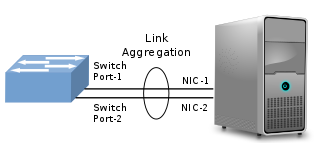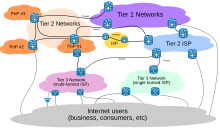The Internet protocol suite, commonly known as TCP/IP, is a framework for organizing the set of communication protocols used in the Internet and similar computer networks according to functional criteria. The foundational protocols in the suite are the Transmission Control Protocol (TCP), the User Datagram Protocol (UDP), and the Internet Protocol (IP). Early versions of this networking model were known as the Department of Defense (DoD) model because the research and development were funded by the United States Department of Defense through DARPA.
Quality of service (QoS) is the description or measurement of the overall performance of a service, such as a telephony or computer network, or a cloud computing service, particularly the performance seen by the users of the network. To quantitatively measure quality of service, several related aspects of the network service are often considered, such as packet loss, bit rate, throughput, transmission delay, availability, jitter, etc.

A router is a networking device that forwards data packets between computer networks. Routers perform the traffic directing functions between networks and on the global Internet. Data sent through a network, such as a web page or email, is in the form of data packets. A packet is typically forwarded from one router to another router through the networks that constitute an internetwork until it reaches its destination node.

Frame Relay is a standardized wide area network (WAN) technology that specifies the physical and data link layers of digital telecommunications channels using a packet switching methodology. Originally designed for transport across Integrated Services Digital Network (ISDN) infrastructure, it may be used today in the context of many other network interfaces.
Open Shortest Path First (OSPF) is a routing protocol for Internet Protocol (IP) networks. It uses a link state routing (LSR) algorithm and falls into the group of interior gateway protocols (IGPs), operating within a single autonomous system (AS).

Network address translation (NAT) is a method of mapping an IP address space into another by modifying network address information in the IP header of packets while they are in transit across a traffic routing device. The technique was originally used to bypass the need to assign a new address to every host when a network was moved, or when the upstream Internet service provider was replaced, but could not route the network's address space. It has become a popular and essential tool in conserving global address space in the face of IPv4 address exhaustion. One Internet-routable IP address of a NAT gateway can be used for an entire private network.
Traffic shaping is a bandwidth management technique used on computer networks which delays some or all datagrams to bring them into compliance with a desired traffic profile. Traffic shaping is used to optimize or guarantee performance, improve latency, or increase usable bandwidth for some kinds of packets by delaying other kinds. It is often confused with traffic policing, the distinct but related practice of packet dropping and packet marking.
Network congestion in data networking and queueing theory is the reduced quality of service that occurs when a network node or link is carrying more data than it can handle. Typical effects include queueing delay, packet loss or the blocking of new connections. A consequence of congestion is that an incremental increase in offered load leads either only to a small increase or even a decrease in network throughput.
Deep packet inspection (DPI) is a type of data processing that inspects in detail the data being sent over a computer network, and may take actions such as alerting, blocking, re-routing, or logging it accordingly. Deep packet inspection is often used for baselining application behavior, analyzing network usage, troubleshooting network performance, ensuring that data is in the correct format, checking for malicious code, eavesdropping, and internet censorship, among other purposes. There are multiple headers for IP packets; network equipment only needs to use the first of these for normal operation, but use of the second header is normally considered to be shallow packet inspection despite this definition.
Class-based queuing (CBQ) is a queuing discipline for the network scheduler that allows traffic to share bandwidth equally, after being grouped by classes. The classes can be based upon a variety of parameters, such as priority, interface, or originating program.

NetFlow is a feature that was introduced on Cisco routers around 1996 that provides the ability to collect IP network traffic as it enters or exits an interface. By analyzing the data provided by NetFlow, a network administrator can determine things such as the source and destination of traffic, class of service, and the causes of congestion. A typical flow monitoring setup consists of three main components:

In computer networking, link aggregation is the combining of multiple network connections in parallel by any of several methods. Link aggregation increases total throughput beyond what a single connection could sustain, and provides redundancy where all but one of the physical links may fail without losing connectivity. A link aggregation group (LAG) is the combined collection of physical ports.
A middlebox is a computer networking device that transforms, inspects, filters, and manipulates traffic for purposes other than packet forwarding. Examples of middleboxes include firewalls, network address translators (NATs), load balancers, and deep packet inspection (DPI) devices.
Bandwidth management is the process of measuring and controlling the communications on a network link, to avoid filling the link to capacity or overfilling the link, which would result in network congestion and poor performance of the network. Bandwidth is described by bit rate and measured in units of bits per second (bit/s) or bytes per second (B/s).
WAN optimization is a collection of techniques for improving data transfer across wide area networks (WANs). In 2008, the WAN optimization market was estimated to be $1 billion, and was to grow to $4.4 billion by 2014 according to Gartner, a technology research firm. In 2015 Gartner estimated the WAN optimization market to be a $1.1 billion market.
The Skype protocol is a proprietary Internet telephony network used by Skype. The protocol's specifications have not been made publicly available by Skype and official applications using the protocol are closed-source.
In computing, Microsoft's Windows Vista and Windows Server 2008 introduced in 2007/2008 a new networking stack named Next Generation TCP/IP stack, to improve on the previous stack in several ways. The stack includes native implementation of IPv6, as well as a complete overhaul of IPv4. The new TCP/IP stack uses a new method to store configuration settings that enables more dynamic control and does not require a computer restart after a change in settings. The new stack, implemented as a dual-stack model, depends on a strong host-model and features an infrastructure to enable more modular components that one can dynamically insert and remove.
Data center bridging (DCB) is a set of enhancements to the Ethernet local area network communication protocol for use in data center environments, in particular for use with clustering and storage area networks.
Traffic classification is an automated process which categorises computer network traffic according to various parameters into a number of traffic classes. Each resulting traffic class can be treated differently in order to differentiate the service implied for the data generator or consumer.
cFosSpeed is a traffic shaping software often bundled with MSI motherboards for the Windows operating system. The program attaches itself as a device driver to the Windows network stack where it performs packet inspection and layer-7 protocol analysis. It has been noted as causing some issues with network connections, and can be difficult to uninstall when bundled.





